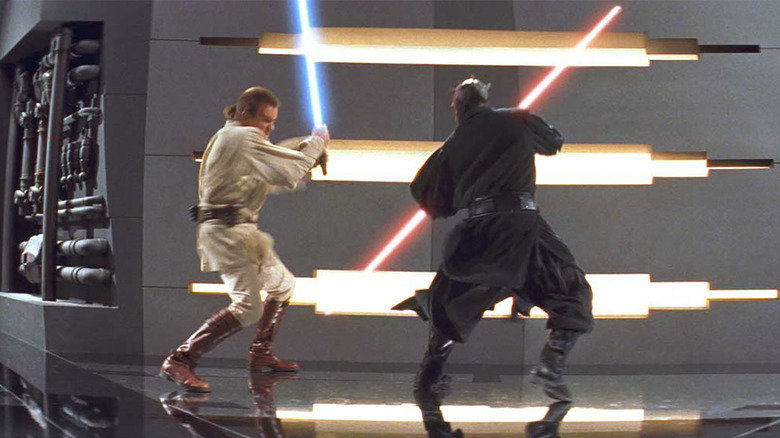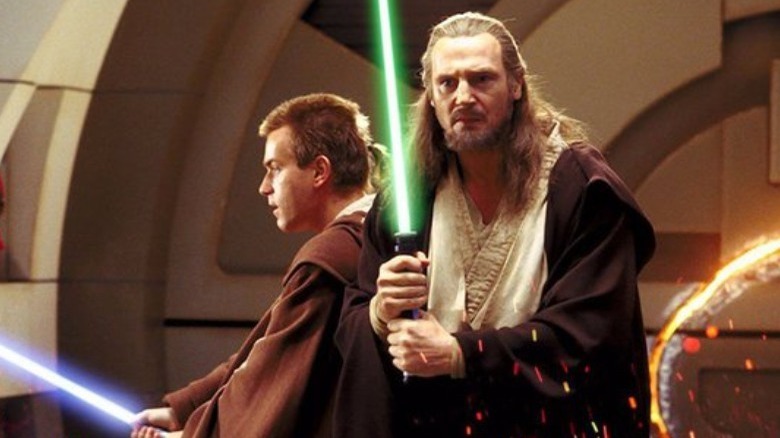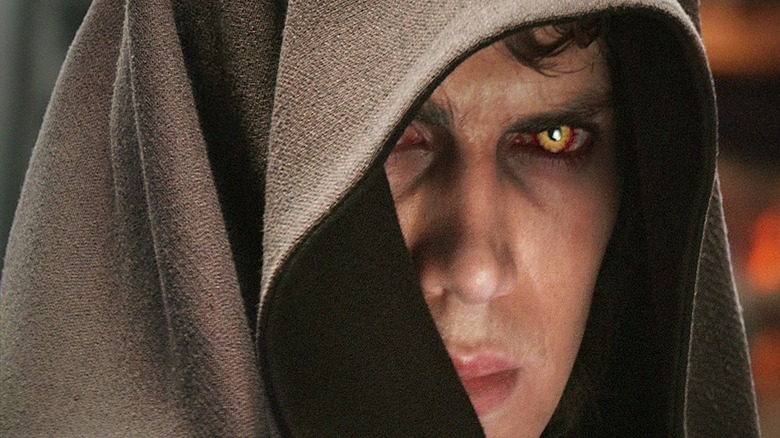How George Lucas' Private Worldbuilding Became The Star Wars Prequel Series
The "Star Wars" movies are undoubtedly a huge achievement. The first one helped usher in the era of the modern blockbuster with an escapist space opera that brings the best of old serials like "Buck Rogers" and "Flash Gordon" to the big screen with new technology and longer stories. It gave us iconic characters, one of the best movie scores of all time, and a universe that keeps expanding to this day.
That last part is arguably the biggest achievement of George Lucas' original 1977 film. With "Star Wars," he created a huge sandbox any creative could play in while adding and changing things in order to create new and exciting stories. This has also led to TV shows like "The Clone Wars" and "Andor," two of the overall best stories ever told in the franchise.
The endless possibilities, exciting lore, and deep mythology of the "Star Wars" franchise are what make this galaxy far, far away so fascinating and worth visiting over and over again, not unlike J.R.R. Tolkien's Middle-earth or the best RPG worlds. But like many RPG dungeon masters, George Lucas overdid it with creating the lore and the backstories before his players even showed up at the table. By the time the first "campaign" was done, Lucas had so much background information in his head, he could literally make a whole new movie trilogy out of it — which is exactly what he did.
Lots of backstories
As part of the oral history of "Star Wars: Episode I — The Phantom Menace" published on StarWars.com in 2019, George Lucas talked about basing the plot of his "Star Wars" prequel trilogy on the backstories he had written to establish the world of "Star Wars" prior to the very first film. It's been widely reported that Lucas came up with a lot of background information while making the original 1977 film that was ultimately cut from the movie, such as a six-paragraph opening crawl that Brian De Palma helped edit down.
According to Lucas, he had to come up with an explanation of what the Jedi were, what the Sith were, and how the Empire came to be. Though the word Sith wasn't uttered until "The Phantom Menace," the word was included in a rough draft of the first film written in 1974, which refers to Darth Vader as a "Dark Lord of the Sith." Likewise, the novelization of the original "Star Wars" retains some of this backstory concerning Palpatine's rise to "President of the Republic" before declaring himself Emperor.
"I spent a lot of time in developing those elements, and what each planet did, and why they did it the way they did," Lucas explained. "So I had all this material. A lot of the story elements were givens." Even the concept of the midi-chlorians and their role in the birth of Anakin Skywalker was reportedly conceived by Lucas as early as 1977, according to the book "The Making of Star Wars."
As Lucas told it, he had to come up with in-universe explanations for the many, many sci-fi concepts the first "Star Wars" was to introduce, and his scripts for the prequels was mostly his way of filling in the gaps in his backstories.
It's all in the details
Take, for example, the structure of both the Jedi Order and the Sith, which George Lucas had already sort of established prior to the prequels. Because the original "Star Wars" film revealed there used to be a lot more Jedi before the Empire, Lucas had to follow through by including hundreds of Jedi in his prequel trilogy. But when it came to the Sith, Lucas had a vastly different explanation in mind than many fans had imagined.
"Everybody said, 'Oh, well, there was a war between the Jedi and the Sith,'" Lucas noted. "Well, that never happened. That's just made up by fans or somebody."
Instead, Lucas imagined the Sith had once ruled the galaxy, only to be spurred by their greed and selfishness into killing one another in an effort to become the most powerful of their kind. Hence, the Rule of Two, wherein you can only have a single Sith master and apprentice at any given time (with the apprentice always trying to recruit his own apprentice to challenge and replace their master). "There can't be any more because they kill each other," added Lucas. "They're not smart enough to realize that if they do that, they're going to wipe themselves out. Which is exactly what they did."
Like so many dungeon masters, Lucas spent way too much time thinking about the history and lore behind every aspect of his original story, providing him with extra material for even more stories. In the end, the sole purpose of these backstories was to explain things that perhaps didn't need explaining.
"I had all the backstory, I had basically the three scripts. Or at least the material that was in the three scripts. Then it's just a matter of doing the details," Lucas admitted.


